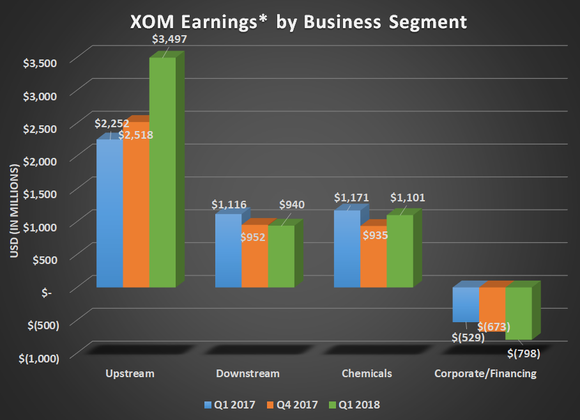Investing in ExxonMobil (XOM +0.13%) has always been for more patient investors as it generates value for shareholders through the ups and downs of the oil business. Being a stock for patient investors means that patience is going to be tested from time to time, and whoo boy, is this one of those times. Even though earnings are on the upswing, they are nowhere near as appetizing as some other companies' recent results.
Let's take a look at ExxonMobil's most recent results, why they seem so weak comparatively, and what an investor should do faced with what could be a string of disappointing earnings results in the near future.
By the numbers
| Metric | Q1 2018 | Q4 2017 | Q1 2017 |
|---|---|---|---|
| Revenue | $68.21 billion | $66.51 billion | $58.67 billion |
| Net income | $4.65 billion | $8.38 billion | $4.01 billion |
| EPS | $1.09 | $1.97 | $0.97 |
| Operating cash flow | $8.51 billion | $7.4 billion | $8.17 billion |
DATA SOURCE: EXXONMOBIL EARNINGS RELEASE. EPS= earnings per share.
Even as someone who is quick to defend ExxonMobil, I have to admit that these results are curiously weak. In a vacuum, a net income increase of 16% sounds fine, but when you consider how much oil prices have increased over the past six months and some of the results its peers have cranked out this past quarter, these numbers don't pack much of a punch.
Looking at the company's results, the thing that stands out the most is its upstream production business. Sure, downstream and chemicals both saw earnings decline compared to this time last year, but that is how those two business segments are supposed to operate (higher oil prices means higher feedstock costs and lower margins). While upstream benefited immensely from the run-up in prices, production continues to decline such that it isn't realizing the benefits of these prices as much as its peers.

DATA SOURCE: EXXONMOBIL EARNINGS RELEASE. CHART BY AUTHOR. *ADJUSTED TO EXCLUDE THE IMPACT OF U.S. TAX CHANGES AND ASSET IMPAIRMENTS IN Q4 2017.
A decent portion of that production decline was a result of an earthquake that shut down operations at its LNG liquefaction facility in Papua New Guinea, which knocked out 25,000 barrels of oil equivalent per day. However, it's pretty apparent from these results that its current slate of new projects coming on line and its growth in shale isn't enough to offset the decline of mature assets and some of its small divestments.
The highlights
- Total oil and gas production decreased 6%(!) compared to the prior year to 3.89 million barrels of oil equivalent per day, or down 3% if we adjust for asset sales and planned downtime.
- Announcements of project start-ups were quiet for the quarter, but management did note that it had increased the total number of rigs drilling in the Permian Basin to 27 and expects shale oil production to increase 18% this year.
- The company announced a seventh discovery on its acreage in Guyana, and management has elected to send a second offshore rig to the region to accelerate exploration and development of that particular asset. Its Liza project, which got the green light last year, is expected to produce first oil as early as 2020, and these accelerated development plans could mean even more production from the region. Management also announced that one of its natural gas discoveries in Papua New Guinea was 84% larger than its original assessment and that it is in discussions with partners to double the size of its LNG plant there to monetize these gas fields.
- Exxon also announced it won bids for 10 new offshore blocks: eight in Brazil, one in Ghana, and one in Namibia.

Image source Getty Images.
What management had to say
The one message that ExxonMobil's management has been communicating lately is patience. In its most recent analyst meeting, it highlighted a slew of projects to grow production and generate loads of cash to reward shareholders. Exxon's VP of investor relations, Jeff Woodbury, reiterated that point while also explaining the less-than-great upstream results during the company's conference call:
In Upstream, we benefited from higher realizations for both liquids and natural gas. However, our liquids realizations rose less in the benchmark prices due to widening of the Canadian heavy oil discount. These higher prices resulted in lower volume entitlements. Production was also reduced by downtime in the quarter and divestment of assets.
We're continuing to progress growth initiatives as outlined in our Analyst Meeting, including increased drilling in the Permian, advancing attractive new projects, and completing maintenance activities to enhance performance of our existing assets.
Finally, we're actively strengthening our portfolio through the acquisition of new assets, such as exploration acreage offshore Brazil.
(You can check out a transcript of the whole conference call here).
As Grandma always said, patience is a virtue
As a stock, ExxonMobil is incredibly polarizing. On the one hand, its recent earnings results have left a lot to be desired when compared to its peers. On the other, it has a seven-year growth plan that might make your mouth water. The trouble is that the real needle-moving projects in that plan won't go live until 2020 or later.
That leaves investors in a bit of a quandary. Should you buy into ExxonMobil now while it's cheap, wait for a post-2020 payout, and run up a sizable aspiring bill from banging your head on the table after every earnings report; or put money into a better-performing big oil player today and check out Exxon at a later date? I think the answer lies somewhere in the middle. For those already invested, it's worth hanging on and letting the forehead bruises accumulate, but if you have some cash burning a hole in your pocket, it may be best to look at adding some of Exxon's peers to your portfolio.

